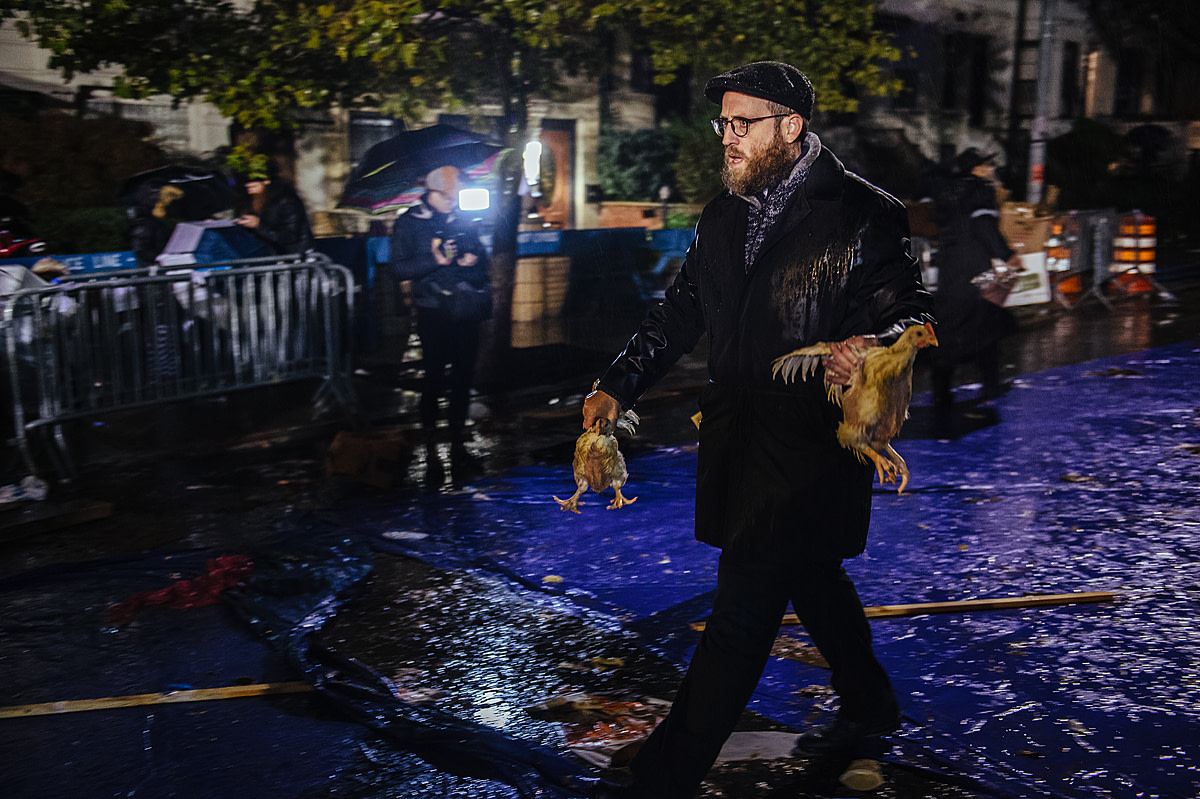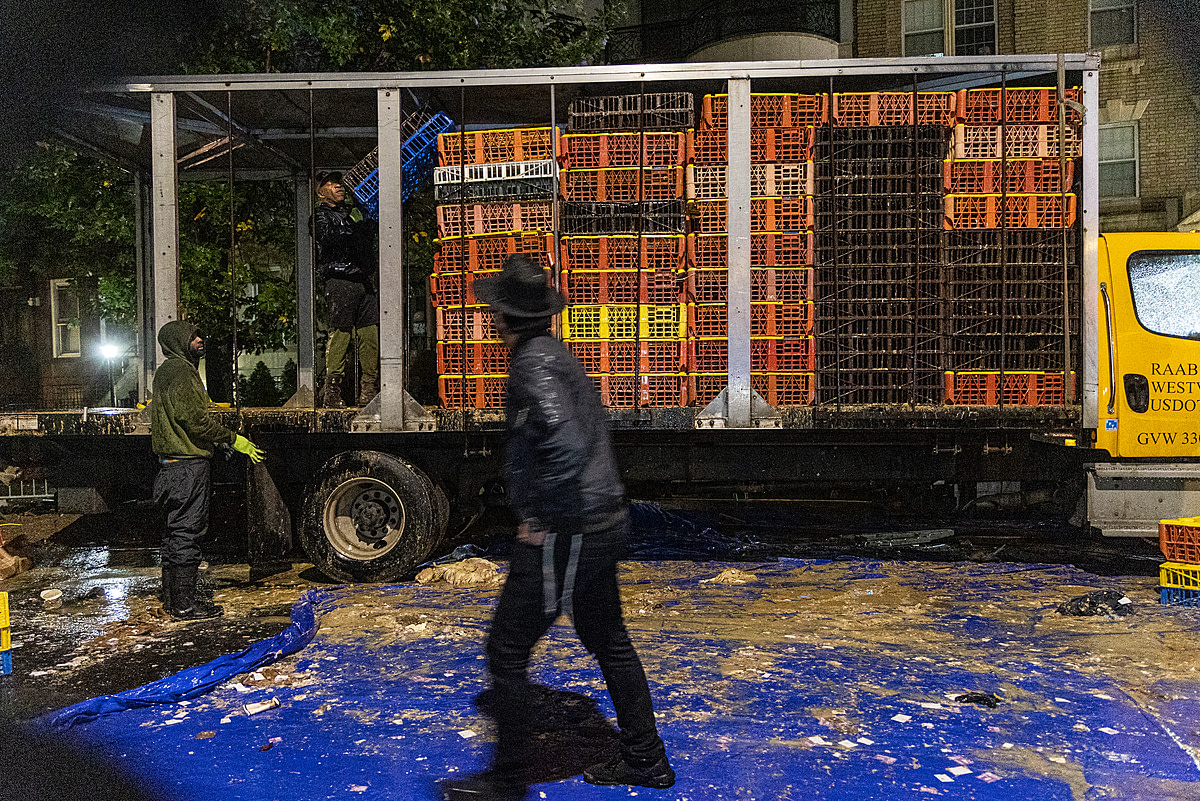Documenting Kaporos Chicken Slaughter in New York
Kapparot, or Kaporos, a ritual practiced by certain sects of orthodox Jews before Yom Kippur, the Day of Atonement, is taking place this week in New York. In 2022, We Animals Media photojournalists Kelly Guerin, Molly Condit and Victoria de Martigny headed to Brooklyn, New York to document the treatment of animals at this annual event.
Content warning: Contains some upsetting images and video footage.
“Even though there are other people who do it in my community (and they’re good people), treating a chicken like this on the eve of Yom Kippur, when we’re asking God for compassion… and we’re not treating this animal with compassion, what are we doing?” – Rabbi Donn Gross
Traditionally, during Kaporos, a live chicken is swung over the head of a practitioner three times while a prayer is recited and the sins of the practitioner are symbolically transferred to the chicken. On the eve of Yom Kippur, the chickens are handed to a shochet (a person certified to kill animals in accordance with shechita law) to be killed and the meat donated to the poor – or eaten at the pre-Yom Kippur meal.
“The practitioners told us the chickens were given to the poor after the sacrifice. Yet what we saw, and what we documented very clearly was most of them ending up in garbage bags or on the street. Dead bodies everywhere. But sadly, many of them weren’t dead yet.” – Victoria de Martigny, animal photojournalist
Kaporos practitioners line up with their chickens outside a makeshift slaughterhouse constructed inside a dumpster on a public street. Each practitioner hands their chicken to a waiting rabbi who slices open the chickens’ throats and then throws the animal aside. Crown Heights, Brooklyn, New York, USA, 2022. Kelly Guerin / We Animals Media
“Witnessing the indifference and insensitivity that some practitioners and members of the community expressed towards the chickens was quite chilling, and our presence was contested everywhere.”– Molly Condit, animal photojournalist
In 2022, it rained for four days straight and thousands of chickens were left outdoors in plastic crates with no food or water or protection from the elements. Many were sick and some died in the crates, yet workers and practitioners, including children and the elderly, handled the chickens with bare hands, putting them at risk of contracting bacteria from the birds.
During our time on the ground our photojournalists also documented the efforts of animal advocates who worked tirelessly on the frontlines to rescue injured birds and provide them with urgent care.
We Animals Media photojournalist Kelly Guerin gently cradles a chicken pulled from a crate of dead and dying birds left on a street outside a butcher shop. Brooklyn, New York, USA, 2022. Victoria de Martigny / We Animals Media
As the event progressed, the amazing volunteers from Jewish Veg and End Chickens as Kaporos were trying to offer watermelon and water to the animals who hadn’t had food or water in several days. But the chickens were so despondent, they had given up hope. They were not interested in food or water. They were shivering, huddling in these crammed cages for warmth and comfort.”– Victoria de Martigny, animal photojournalist
A chicken rescued from the Kaporos ritual curiously peers at the camera. This bird is among hundreds recuperating at a triage area set up by volunteers with the Alliance to End Chickens as Kaporos. Brooklyn, New York, USA, 2022. Victoria de Martigny / We Animals Media
Although the custom dates back to Talmudic times, some Jewish Rabbis oppose using chickens as Kaporos and instead advocate for using coins and then donating the money to the poor. Rina Deych, who grew up in an Orthodox household is a founding member of The Alliance to End Chickens as Kaporos and says, “It violates state laws and halacha, not the least of which is tzar baalei chayim (causing distress to a living animal).”
“We all innovate. None of us are practicing our religion the way our ancestors did. Change is the only constant, but we all think change can’t happen.” – Rabbi Donn Gross
Our photojournalists have documented the exploitation of animals for ceremony and religious use all around the globe. These stories serve not to point the finger at specific communities or beliefs, but to provide a glimpse into the experiences of the individuals impacted by our rituals and traditions. These visuals encourage us to reflect on our values and reconsider our relationship with other animals, as many Jewish advocates are doing.
Explore more visuals via our stock platform, which offers 20,000+ free images and videos of animal issues around the globe.
Donate today and help us continue to produce compelling global investigations into these cruel practices.
More like this from We Animals Media:
Interview with Photographer Molly Condit
by We Animals Media | Oct 24, 2022











